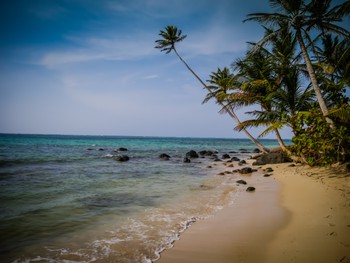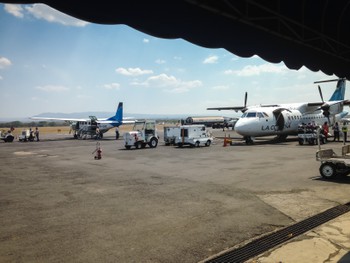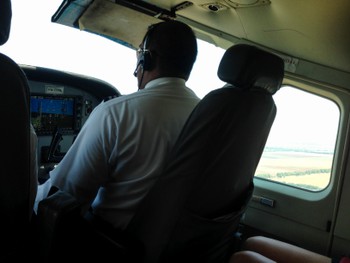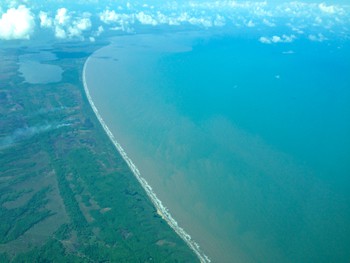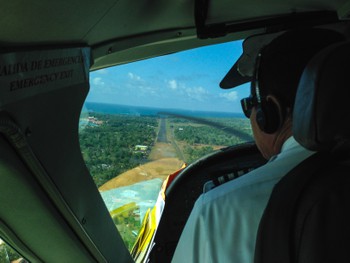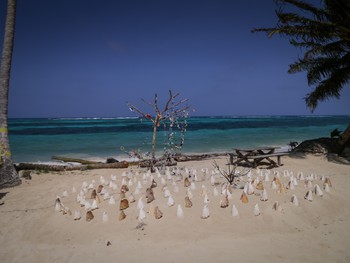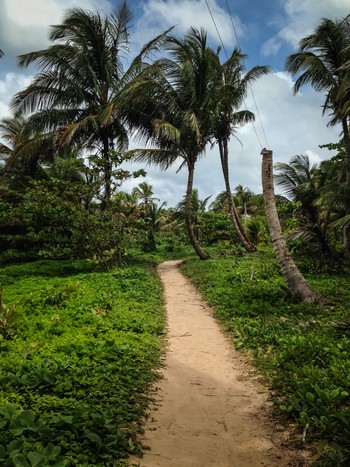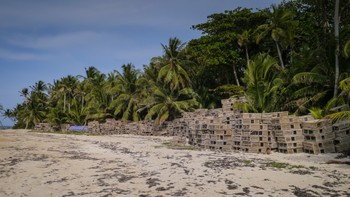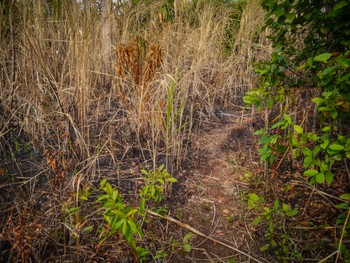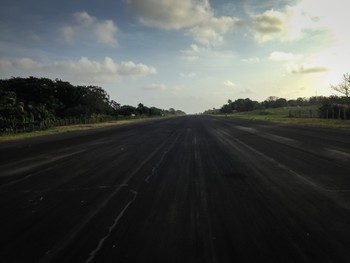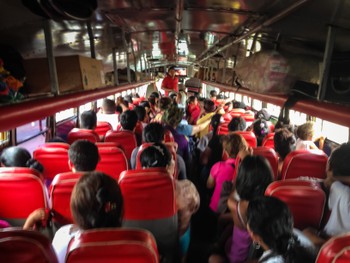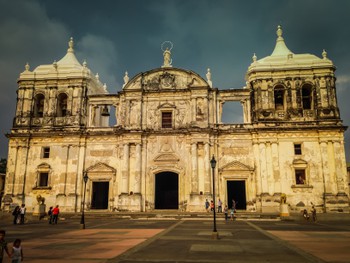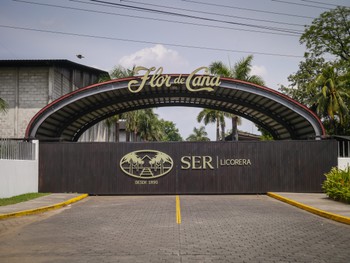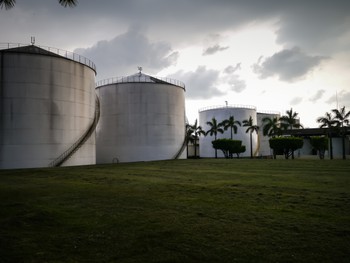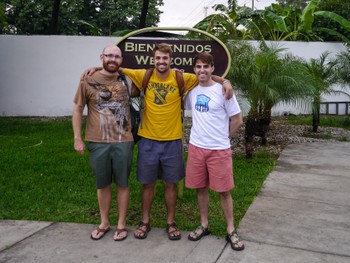Little Corn Island, Leon, And A Visa Run
After I was done hiding out in Esteli over easter, trying to avoid the masses of locals who apparently usually head to the coasts and cause a ruckus, I booked a flight from Managua to Big Corn Island. This was the most last minute flight I've booked thus far, less than 24 hours before the time of the flight, although it made no difference at all to the cost. Hooray for fixed price flights!
I played the “put everything heavy on my person and as much as possible in my carry-on” game to make sure I beat the 15kg luggage limit. It turned out that at the airport they actually get you to hop on the scale with your carry-on (passenger weight actually matters on such small planes), but I felt pretty safe that me and my bags would probably still weight less than some of the obese people I'd seen on buses.
Knowing it was a small plane, I was very surprised by the number of people at the airport, the waiting area was packed! It turns out they run multiple planes along the route for each scheduled flight. That day it was two little single propeller 12 seaters and one bigger plane. I got put in one of the 12 seaters, and scored a seat directly behind the pilot.
We flew quite low for most of the flight giving nice views of the country, maxing out at 9500 feet (I could read the dials from where I was sitting). Looking down from a tiny little plane like that makes flying feel wondrous, like it really should.
As we were flying over the last of the mainland, the terrain below us was very swampy and wet, and the Caribbean sea close to shore was all brown and murky looking for about half a kilometre before it turned into a nice blue like on the post cards.
On landing I was impressed and surprised by just how quickly the plane came to a halt. I wonder how long the tyres on one of these little planes last, braking like that?
Collecting luggage was a disorganised mess. Three planes full of people crammed into a 4M x 4M room, with guys bringing the bags in a few at a time, and checking your baggage tags matched. Mine thankfully came up quite early on, some people had to wait for a fourth plane to come with their luggage.
From the Big Corn Island airport, I shared a cab to the dock where I caught a ferry to the place I actually wanted to be, Little Corn Island. The seas were a lot rougher than they had looked from the air, but a seasickness pill kept me feeling fine for the duration of the journey.
The evening I arrived on Little Corn the power was out. The island normally only has power for a few hours a day, but something had gone wrong with the island's generator, so the only places with power were the fancier hotels that had their own generators. This made for a fun time getting my bearings, wandering out in the dark, trying to follow path ways and find somewhere to have dinner. Eventually I gave up and went to the restaurant attached to one of the fancy hotels.
I stayed the first few nights in a place near the pier called Three Brothers, but that side of the island doesn't get much wind so the place I was in was stinking hot, and inland enough that you don't get the whole island vibe. After a few nights there I moved over to a little cabin on the beach at Elsa's place over the other side of the island for pretty much the same price, where I could see the water from my door, and stepped out my door right onto the sand. Constant cool sea breezes, a much nicer location!
That said, the staff at Elsa's place were some of the least friendly people I've ever met, and there was some stuff about the place that was just plain weird.
There were two towels in my room for me to use (a nice unexpected bonus), but there was no toilet paper in the shared toilets for pretty much the whole time I was there. I ended up stashing my own roll in my room, but I have to wonder what they're using.
Every time I went to the reception to do anything I seemed to get dirty looks from the hoard of staff sitting around, and they all continue sitting around and scream to some woman from out the back to come and serve. I would see them being nice among themselves, laughing and smiling, but as soon as a tourist was involved they'd instantly swap those smiles for scowls and behave like you had insulted their mothers or something. Even when I went to pay for my stay there, the grumpy woman barely did more than grunt at me. Too lazy to get up off her fat arse when I went to the counter, and then she acted very put out when she had to stand up to collect $105 I owed; a lot of money in Nicaragua. I struggle to believe it's just a cultural thing, the family running this place really just seem to hate the very people they rely on for income.
I asked if I could use the laundry sink I'd seen near my room. No. I asked if they had a laundry service. No. I asked if they could tell me somewhere I could go to get my laundry done. No. Ok, screw you then. I'm going to take stupidly long showers wearing my dirty clothes to wash them in there then. Backpacking life.
I spent a lot of time spinning poi while I was on the island. Nearly every day I'd find somewhere nice and shady and put on an album and just play around practicing different things until the album stopped. Some days I'd do a second album back to back. I was trying to focus on doing things slowly and with more control, and I found the Amelie soundtrack as nearly perfect for that, with Opiuo's Meraki thrown in for something a bit more upbeat now and then. Definitely saw some good improvement during the time I was there.
The diving on Little Corn, the whole reason I was there, was fantastic. Lots and lots of big marine life. I think I saw at least one nurse shark on every single dive, often more. One dive we had a small one follow us around the entire dive like a cute little puppy dog. Most dives I'd also spot loads of southern stingrays, lobsters, juvenile angel fish, baby drumfish, spotted trunkfish, trumpet fish, Atlantic spadefish, blue tangs, scorpionfish, groupers and creole wrasse. The reef seemed to very quite healthy, with some of the more colourful coral I'd ever seen. Lots of purples tubes and greens fans for a change.
After being buddied up with noobie photographers far too many times I’ve developed my own set of rules for buddy’s on recreational dives, which goes against everything PADI teaches, but PADIs buddy rules were made before every other fuckwit with 4 dives under their belt bought a GoPro so I don't think they're a good fit for random pairings.
1. If you have a problem, the nearest person is your buddy. 2. Likewise, Always help someone who needs it. 3. Never go to far from the nearest diver that you don’t think you could make it back again without another breath of air. 4. Conversely, give me some space and don't dive right on top of me. Anyone should be able to hold their breath for 20-30 seconds, or maybe they should reconsider getting the in the water. 5. Be responsible for yourself.
These are the (unspoken) rules I stick to when buddied up with someone I’ve never met before. Sorry if that makes me a dick, but I don’t know what sort of a diver you are so I'm expecting the worst.
I'm not going to follow you around while you scare sea-life sticking your GoPro in their frightened faces. If something goes wrong and I need air, I'm not wasting time trying to figuring out who and where you are; I'm going to get air wherever it's available, the nearest person. Then, once the high-stress incident is over, I can find my “buddy”, or more likely the DM for advice on what step to take next; most likely to abort the dive.
Forget PADI/SSI's buddy system when you’re diving with holiday divers you’ve never even met before, it's just not safe or realistic. Rant over
One new thing I'd never seen before now is the spearing of lionfish to protect the reefs in the Carribean. Lionfish are actually a species from Asia that have accidentally been introduced here, that have very few real predators while they eat the juvenile offspring of the fish native to here. And thus, pretty much every dive guide will carry a spear with them and spear any lionfish they see, often then feeding them to a passing nurse shark.
This has had the interesting effect on nurse shark behavior that they will now follow groups of divers around during dives, hoping to get an easy meal.
It's interesting to see how others seem giddy to be killing something and feeding it to sharks or the lobsters. I actually kind of feel sorry for them. We are pretty much all "introduced" humans. We've done bad things to the environment, and wiped out entire species. Imagine if we were targeted for elimination as pests/danger to the place we lived.
I got the chance to go out on just one night dive, but I got to see almost everything you could hope to see on a night dive. A mushroom scorpion fish, 7+ southern stingrays, a friendly little remora who snuck up on the sand next to us while we had lights out to check the bioluminescence and then stayed there watching when we turned them our lights back on, a toadfish. I spotted a Caribbean reef octopus amongst some seaweed with nowhere to hide, it was awesome to see him changing colours, through yellow, blue and green trying hopelessly to hide. We saw 2-3 green turtles and a giant big loggerhead as well, some peacock flounders hiding on the sand, a reef squid , some nudibranch, lots of lobsters and hundreds of shrimp. You could spot the shrimp from quite a distance as their eyes reflect the torchlight back as little pink dots on the coral and rocks. Some were quite big, and really fast moving. As is often the case, the night dive was easily my favourite.
(Sorry about how text heavy this is. Feel free to gift me an underwater camera and I promise my diving posts will be way more interesting!)
One afternoon I walked almost the entire way around the island, along the beach past all the fancy hotels that I could never afford to stay at, to lots of beautiful stretches with nothing built along them, just natural as they should be and lined with coconut forrest. Eventually I got to a point where it was just pretty much vertical cliffs with waves crashing against them, so I went up a part that wasnt completely straight up, and ventured along random goat tracks in the forest until I found the village.
I was half expecting to stumble across some secret hideout for Columbian drug smugglers, but all I found was a big chunk of forest that had recently had a big fire. No idea how they would have managed to put it out, they may have just had to let it burn out.
Guessing how long I would want to be on Little Corn Island up front (by booking my flight as a return) meant there were a few days after I was done diving where I didn't have very much to do; not always a bad thing. I got in lots of reading, resting and practicing poi. But I was definitely looking forward to getting off the island towards the end. Not having internet was making it very hard to work out what I would be doing once I was back on the mainland.
Visa Run ========
After Little Corn, I got the ferry back to Big corn and spent the night there before my flight the next morning. I walked from where I was staying to the airport terminal via a shortcut directly across the runway tarmac!
This flight I was put on a bigger place, which flew via Blue Fields. This was much less exciting than flying in the small plane.
Still not having committed to what I wanted to do when I arrived, I decided mid-flight that when I landed I was going to head straight for the Costa Rican border to do a visa run. Having spent nearly 3 months in Nicaragua, My CA-4 visa that was supposed to cover Nicaragua, Honduras, El Salvador and Guatemala was nearly expired and I hadn't even made it to two of them yet.
As is always the case, the taxi from the airport to the bus station cost more than the buses from there, half way across the country to the border and into Costa Rica. I'd heard bad things about this border crossing taking hours on occasion, but again I managed to get through in under 30 minutes. Maybe I'm lucky, or maybe it's because I'm doing things on the local buses instead of with a bus full of other foreigners clogging things up. I dunno.
A had to wait out 72 hours in Liberia and I didn't really do much beyond reading, working through my Spanish workbook and sorting photos. Coming back from Nicaragua, I was sort of blown away by just how expensive Costa Rica seemed. Last time coming from the UK it had seemed cheap!
Crossing back into Nicaragua didn't go quite as smoothly. I found out that Costa Rica had started charging an departure tax since the last time I did this crossing, and I found out the only place you could pay it was, not at the border where you'd like, but half a kilometre back into Costa Rica at a shitty little office. It's a $7 tax, plus an unavoidable $2 "service charge" and it took them half an hour to do whatever it is they're doing. They do accept their own currency, but the rate they offer is terrible.
Honestly, I don't know why countries do stupid stuff like this. It just means you leave their country on a sour note. It's going to be the most recent thing in your memory associated with the country. Not the nice time you had at the beach, but how they made you walk a kilometre in the hot sun with heavy bags, and then made you stand around and wait to pay a stupid tax. I'd rather have bribed a border guard $10 and not have to mess around with this nonsense, but I'm not that ballsy.
Leon ====
My original plan was to try and make it as close to the Honduran border as I could in a day, so I could try and do the run up to San Pedro Sula the following day, but as luck would have it a bad childhood tooth filling that regularly seems to cause me troubles started to feel like it was coming loose, and having heard that Nicaragua was America's equivalent to Thailand for dental work, I figured I would stop and get it looked at.
I made it to Leon by about 5pm, found a hostel and then got them to recommend a dentist, and by 6:30 I was in the dentist chair getting two old fillings that she identified as bad drilled out. Amazing how quickly it all went down.
Oddly enough she started with no anaesthetic at all until I asked for some when she was getting near the nerve. I expected maybe this was a cost thing and I'd have to pay more for the anaesthetic, but that didn't seem to be the case.
Unfortunately, the dentist didn't have time to do the replacement fillings the same day, so she put in a temporary one for me for the night.
I went back the next day and got the two fillings replaced properly, one in the morning and one in the afternoon. She said the ones I had were terrible, which I thought so myself. Apparently there's some sort of laboratory filling you can get that the dentist thinks I should look into in the next few years. I was a bit unclear on some of that, since she only spoke Spanish and these aren't the kind of words you learn at language school.
The dental work seemed great for the money (less than $100), although I now have a gap between those two teeth that never used to be there, which gets food stuck in it anytime I eat, which is super annoying. I've never really worried about flossing since my teeth are all so close together that stuff never really gets between them, but now I need to do that one gap every time I eat :/
While I was in Leon I tried to book a tour up to Volcan Telicia, one of the Volcanoes where you can actually see glowing lava, but apparently I was the only person who signed up so it didn't go ahead. Disappointed. Some day I'll see lava glowing.
Instead I took myself out to the Flor de Caña factory to do a tour of that. For those who know, Flor de Caña is a rum made in Nicaragua, and it's really damn tasty stuff. I'd never really drunk much rum before coming to Nicaragua, but I drank a lot of it while I was there and learned an appreciation for the good stuff, straight up.
It was a pretty cosy tour, just me and two American brothers. We drove past the giant vats of molasses, each holding 1,000,000 litres of molasses. I couldn't help but imagine the thought of a vat failure, and molasses running everywhere very slowly.
I learned a lot of interesting stuff about rum on the tour:
* I was told that white rum loses it's colour due to the filtration process they use. * They claim they just put alcohol in the barrels, not rum. Then being in the barrels is what makes it into rum. * 6% of the barrel volume is lost to evaporation every year, meaning that to end up with a decent volume of aged rum, you need to start with a whole lot more. * 25 years is the oldest rum that they make, which is also the age of a barrel that needs replacing and around about the time the civil issues in Nicaragua were settling down. * The barrels are bought from American whiskey companies, I saw both Jim Beam and Wild Turkey labels. The barrels are all stripped down and rebuilt before use. * They make some big environmental claims, claiming they use 100% renewable energy from burning sugar cane husk, do an epic amount of recycling, lots more I don't remember now. Seems to be at odds with the views I'd heard previously about how evil they were and are killing their workers.
We did a tasting of the 18 year old rum in this beautiful room that used to be a cellar, with furniture made from the wood of old rum barrels. It was really pretty but they wouldn't allow photos down there :( I'll never understand why that's a thing. They showed us how the 18 year old has no remaining sugars, by getting us to put a little bit in the palm of our hands and rub it dry, showing that it really doesn't leave any sticky residue.
Later at the end of the tour we got to try the 7 year old with soda, but I'd already drank plenty of that. What I really wanted was to try the 25 year old, even if I had to buy a nip of it, but it was only on offer by the bottle for $161. Just a wee bit out of my budget. For reference, in Nicaragua the 7 year old can be found for $7-9, the 18 year old is about $40. There really is a huge jump in price for those last 7 years of aging!
And that finally wraps up Nicaragua!
